Roadways
The collapse of 11 overpasses on some of the busiest freeways in Los Angeles and the San Fernando Valley attracted much media attention. More than a month after the earthquake, there were still massive traffic disruptions in an area almost entirely dependent on automobiles. Sections of Interstate (I) 5 and I-10 (the Santa Monica Freeway) were still closed.
-
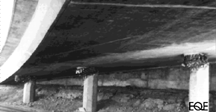
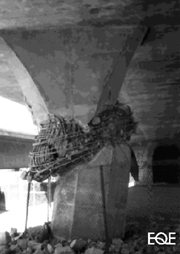
Damage to freeway columns from the 1971 San Fernando Earthquake is shown in the top photograph. For architectural reasons, tapered columns were introduced in the early 1970s. Regretfully, many tapered columns in unstrengthened structures failed in the 1994 Northridge Earthquake, as shown in the bottom photograph. However, retrofits made after the 1989 Loma Prieta Earthquake all proved to be successful.
After the dramatic failure of elevated freeway structures in Northern California’s 1989 Loma Prieta Earthquake, the California Department of Transportation (Caltrans) initiated a program to retrofit all inadequately designed elevated structures, including overpasses, bridges, and walkways. Caltrans identified 860 structures that required retrofit, 456 of which were in the Los Angeles area. At the time of the Northridge Earthquake, 122 structures had been strengthened, and work was in progress on another 43. Before the earthquake, it was expected that the strengthening program would be completed by 1995 at a cost averaging about $0.5 million per structure (excluding major bridges).
-
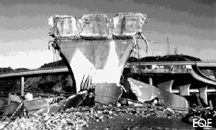
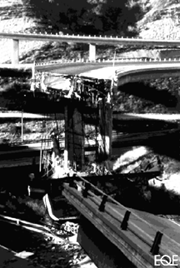
Collapsed sections of the Interstate 5-State Route 14 interchange.
Among the roads closed were I-5 at its intersection with State Route (SR) 14; I-5 over Old Gavin Road near Newhall, about 3 km north of the I-5/SR-14 interchange; the I-5 and I-210 interchange; SR-118 (the Simi Valley Freeway) over Balboa Boulevard just west of I-405, and over the intersection of Gothic Avenue and San Fernando Mission Boulevard in Mission Hills; and I-10 (normally the nation’s busiest road) over La Cienega Boulevard, Venice Boulevard, and Fairfax Avenue in Los Angeles. The I-5/SR-14 interchange partially collapsed in the 1971 earthquake, also.
All of the above damaged overpasses, with the exception of the newer ones on SR-118, had been scheduled for retrofit. The oldest of the collapsed overpasses, on I-10 just west of downtown Los Angeles, was in an area of softer soils, which probably amplified the already very strong ground motions. Inspection on the day of the earthquake indicated that the area might have had roadway damage and possible settlement well before the earthquake. The collapses along SR-118 occurred in an area of extremely high ground accelerations coupled with ground failures. Paving at numerous locations east of the collapses was damaged by permanent ground deformations, possibly faulting.
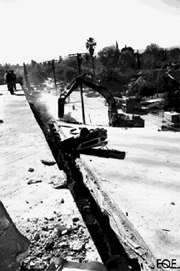
Work to remove this collapsed portion of the Simi Valley Freeway (State Route 118) was underway two days after the earthquake.
Most of the collapses can be attributed to inadequate reinforcing and strength in the older structures. Further, the structures were subjected to ground accelerations that exceed even those used for design of new structures. Reexamination of the State’s design criteria might be justified.
What much of the media missed in its extensive coverage of the overpass failures was that none of the failed structures had been retrofitted (all 122 strengthened structures were undamaged) and that only a few out of several thousand overpasses failed. In effect, a very small percentage of failures occurred under unprecedented ground motions in a metropolitan area. However, even this small percentage caused fatalities and continues to cause widespread public inconvenience. All of the affected structures were built of reinforced concrete. Therefore, there is no diversity of materials and designs by which a comparison of performance characteristics can be made. Other countries, specifically Japan, currently build almost all metropolitan road overpasses and elevated roadways with structural steel because of the superior performance of steel structures in past earthquakes.
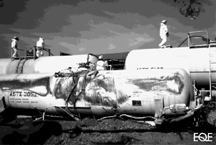
These tank cars containing sulfuric acid derailed during the earthquake. Only one leaked.
Airports
After the earthquake, the Federal Aviation Administration closed Los Angeles International Airport for about 2 hours as a precaution. Minor flooding occurred after the sprinkler system was activated. Other airports in the Los Angeles area were also closed briefly. Hollywood Burbank Airport was reopened following inspections the day after the earthquake.
Van Nuys Airport, about 6 km southeast of the epicenter, was in the area of strongest ground shaking. The glass panels of the control tower broke during the earthquake, interrupting operations of the tower. The airport had no significant structural damage to its numerous large steel-frame hangars, as discussed earlier in the section on “Office and Industrial Parks.”